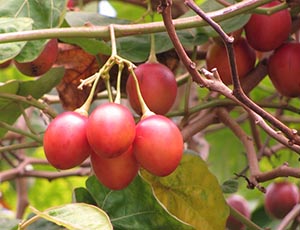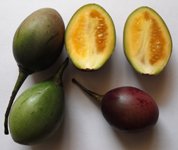Tamarillo Nutrition facts
Juicy, sweet and citric, tamarillo or tree tomato is a small oval-shaped fruit. It is closely related to other Solanaceae members of vegetables and fruits such as tomato, eggplant, tomatillo, groundcherry, and chili peppers.
Some of the common names include tomate de arbol (Spanish), tomate de arvore (Brazil, Portuguese), and tree tomato (English). Scientific name: Solanum betaceum (Cyphomandra betacea).
 |
| Tamarillo (Cyphomnadra betecea). Courtesy: mmmavocado. |
Tree tomatoes are thought to have originated in the semitropical high-altitude Andes forests of Brazil and Peru. They are cultivated on a commercial scale in large orchards in northern parts of New Zealand and exported to the USA, Australia, Japan, and European Union countries.
Tamarillo is a shrub or small size tree reaching about 5-15 feet in height with hairy stems and branches. Its evergreen leaves are broader than in tomato. A well-grown plant bears small fleshy pale-pink attractive flowers in the first year of plantation. However, fruiting is generally discouraged until it reaches the second or third year.
Tamarillo fruit features an oval shape with smooth, shiny skin and can be of different colors depending upon the cultivar type. Red tamarillos are more common than orange-yellow varieties. Completely mature fruit features oval, about 6-8 cm in length and 4-6 cm in width, and weighs about 100 grams.
On the inside, the cut section appears similar to that of plum tomatoes. The flesh is juicy, deep, sweet yet tangy, flavorful, filled with many tiny, flat, disk-like edible seeds that are slightly larger than in tomatoes.
Health benefits of Tamarillos
Tamarillos are one of the very low-calorie fruits. 100 g of fresh fruit contains just 31 calories. They contain slightly more calories, fat, and protein than tomatoes. (100 g tomato has 18 calories). Nevertheless, they have good amounts of health-benefiting plant nutrients such as dietary fiber (3.3 mg or 9% of RDA), minerals, antioxidants, and vitamins.
Acidic flavor (sourness) of tree tomatoes mainly comes from citric acid. The other important acid in them is malic acid.
The ORAC value (antioxidant strength) of 100 g fresh tamarillos is 1659 TE (Trolox equivalents). Their antioxidant value is primarily derived from polyphenolic, flavonol, and anthocyanidin compounds. Some of these phytochemicals include chlorogenic acid, kaempferol, and anthocyanin pigments such as cyanidin glycosides, especially concentrated in their skin. Scientific studies suggest that Chlorogenic acid helps to decrease blood sugar levels in type-II diabetes mellitus.
Yellow and gold variety tamarillo contains more vitamin-A and carotenes than red varieties. However, the red variety has more anthocyanin pigments. In addition, yellow tamarillos are an excellent source of carotenes and xanthins. These compounds possess antioxidant properties and, together with vitamin A, are essential for good visual health. Further, this vitamin is also required for maintaining the integrity of mucosa and skin. Consumption of natural vegetables and fruits rich in flavonoids helps protect from lung and oral cavity cancers.
Tree tomato is a modest source of B-complex vitamins such as thiamin, riboflavin, and pyridoxine (vitamin B-6). Together, these vitamins help as co-factors for enzymes in metabolism as well as in various synthetic functions inside the body.
They are indeed a very good source of electrolyte, potassium. 100 g fresh fruit has 321 mg or 7% of this mineral. Potassium is an important component of cells and body fluids that helps control heart rate and blood pressure, thus countering the bad influences of sodium. Also, the fruit contains a few minerals such as copper, manganese, magnesium, phosphorus, zinc, and iron.
| Principle | Nutrient Value | Percent of RDA |
|---|---|---|
| Energy | 31 Kcal | 1.5% |
| Carbohydrates | 3.8 g | 3% |
| Protein | 2 g | 4% |
| Total Fat | 0.36 g | 1.5% |
| Cholesterol | 0 mg | 0% |
| Dietary Fiber | 3.3 g | 9% |
| Vitamins | ||
| Folates | 4 µg | 1% |
| Niacin | 0.271 mg | 1.5% |
| Pyridoxine | 0.198 mg | 15% |
| Thiamin | 0.043 mg | 3.5% |
| Vitamin A | 630 IU (189.17 µg) | 21% |
| Vitamin C | 29.8 mg | 50% |
| Vitamin E | 2.09 mg | 14% |
| Electrolytes | ||
| Sodium | 1.44 mg | <1% |
| Potassium | 321 mg | 7% |
| Minerals | ||
| Calcium | 10.7 mg | 1% |
| Copper | 0.051 mg | 5.5% |
| Iron | 0.57 mg | 7% |
| Magnesium | 20.6 mg | 5% |
| Manganese | 114 µg | 5% |
| Phosphorus | 38.9 mg | 5.5% |
| Selenium | 0.1 µg | <1% |
| Zinc | 0.15 mg | 1% |
| Phyto-nutrients | ||
| Carotene-ß | 600 µg | -- |
| Carotene-α | 10 µg | -- |
| Cryptoxanthin | 1059 µg | -- |
| Lycopene | 0 µg | -- |
Selection and storage

|
| Tamarillo fruit sections. |
Tamarillo season begins in New Zealand from May until October. Choose well-developed, bright, uniform-colored, ripe, and ready-to-eat fruits. Tamarillos are available in several attractive colors orange, golden yellow, deep red, maroon, etc. Look for the healthy stalk. Avoid small, shriveled, damaged, and bruised fruits.
At home, ripe fruits may stay well for up to 5-7 days and inside the refrigerator for up to 10 days.
Preparation and serving methods
Raw, ripe fruits can be eaten with the peel. However, its skin is bitter in taste (largely because of cyanidin anthocyanin pigments), and many may want to avoid eating it.
At home, wash them in cold water and mop dry using a soft cloth. Remove the stalk. In general, the fruit is cut in half, and its sweet, juicy flesh is scooped out using a teaspoon.
Its skin may be peeled and discarded in a similar fashion as in tomatoes. Rinse the fruit in hot water for 2-3 minutes and cool it immediately by immersing it in cold water. Then using a knife, make a small nick on the surface and gently peel using your fingers.
Here are some serving tips:
Tamarillo slices used in decorating fruit/green salads.
Its slices served as toppings on cakes, ice creams, sandwiches, etc.
Its juicy pulp can be pureed and blended to prepare smoothies, sauce, salsa, jams, jellies, etc.
Safety profile
Tamarillo fruit intolerance is a rare event and may occur because of cross-allergic situations to other Solanaceae commoners like eggplant, tomato, tomatillo, etc. (Medical disclaimer).
Also read ≺≺-
≻≻-Tomatillo (Tomate) Nutrition facts and health benefits.
≻≻-Tomato Nutrition facts and health benefits.
≻≻-Cherry Tomatoes Nutrition facts and health benefits.
≺≺ Back to Fruits from Tamarillo. Visit here for an impressive list of all varieties of fruits with complete illustrations of their nutrition facts and health benefits.
≺≺ Back to Home page.
Further reading and Resources:
New Zealand Tamarillos- Nutritional composition.